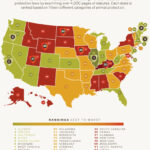In the picturesque landscapes of Minnesota, where nature’s beauty harmonizes with human existence, a critical question lurks beneath the surface: Is animal cruelty a felony in Minnesota (MN)? This inquiry transcends mere legal implications and delves into the ethical fabric of our society. It invites us to consider not only the welfare of animals but also the moral responsibilities we hold as custodians of the planet. Yet, amidst this contemplation, a challenge emerges: how effectively does Minnesota’s legal framework safeguard its vulnerable creatures from cruelty and suffering?
To comprehend the gravity of animal cruelty laws in Minnesota, one must first unravel the nuances of what constitutes animal cruelty. Under Minnesota law, animal cruelty entails an array of actions, including inflicting unnecessary pain, suffering, or death upon an animal. The definitions, however, can become labyrinthine. For instance, unintentional harm may lead to different repercussions than deliberate acts of violence. Yet, no matter the circumstance, the core of the issue remains the protection of sentient beings who share our world.
In Minnesota, animal cruelty is categorized into two primary degrees: misdemeanors and felonies. Understanding these classifications is pivotal. A misdemeanor can arise from acts of neglect or failure to provide adequate care. In stark contrast, felony charges are reserved for more egregious violations, such as torturing, maiming, or killing an animal deliberately.
According to Minnesota statutes, the elevation of animal cruelty to a felony is triggered by specific heinous actions. This distinction serves as a stark reminder of society’s repudiation of atrocious behavior towards animals. For instance, instances where an individual intentionally inflicts severe pain or injury—or, alarmingly, conducts organized fighting among animals—fall under felony charges, which can ultimately result in substantial fines and imprisonment.
It is essential to note that Minnesota is not alone in its efforts to combat animal cruelty. Many states across the nation grapple with similar issues, yet Minnesota’s stringent laws reflect a notable commitment to animal welfare. In comparison with other jurisdictions, Minnesota’s legal framework exhibits a robust stance against heinous acts of violence directed at animals. Nonetheless, this raises another provocative question: Are the laws stringent enough? Or do they leave room for loopholes that could be exploited by offenders?
Moving beyond legalities, it is vital to address the underlying societal attitudes toward animal rights. Minnesota’s laws are undeniably a reflection of collective values. A society that values compassion toward animals inherently seeks to construct frameworks that enshrine their protection. Yet, despite these legal measures, reports of animal cruelty continue to surface, creating a dissonance between law and ethical practice. This contradiction could suggest that the enforcement mechanisms in place may not sufficiently deter potential offenders.
Challenges abound in the realm of enforcement. Animal protection laws necessitate not just well-structured statutes but also the resources and commitment from law enforcement agencies and the judicial system. Animal control officers, local law enforcement, and humane societies must collaborate effectively. Moreover, public awareness campaigns play a pivotal role in educating communities regarding the importance of reporting animal cruelty. Without vigilance from the population, the legal frameworks may falter in protecting those they are designed to serve.
Additionally, the role of public sentiment cannot be overstated. Public advocacy and activism have profound effects on shaping legislation and enforcement practices. It pushes the discourse on animal welfare into the mainstream, fueling tighter regulations and increased funding for animal control initiatives. Notably, grassroots movements have proven to be catalysts for change, rallying communities around the cause of animal rights.
As Minnesota grapples with defining the boundaries of legal protections for animals, it becomes imperative to explore the specifics of enforcement actions. The criminal justice system often faces scrutiny regarding sentences for those convicted of animal cruelty. Are punitive measures sufficient to dissuade would-be offenders, or do they merely scratch the surface of a much larger cultural issue? The conversation surrounding rehabilitation versus punishment must also be examined. How can the system balance justice for the victim—namely, the animal—while also providing pathways for offenders to reflect and reform their actions?
Furthermore, one cannot dismiss the intersection of animal welfare and education. Incorporating animal ethics into educational curricula from a young age can shape perspectives and foster empathy. Teaching children about compassion toward animals instills values that can reverberate throughout their lives, cultivating a generation that understands and appreciates the intrinsic value of all sentient beings.
Consequently, the examination of animal cruelty laws in Minnesota invites a myriad of reflections on humanity’s ethical obligations. Legal frameworks are indeed necessary to curtail acts of cruelty and provide reparative justice for victims. Still, these laws must be buttressed by a cultural commitment to empathy, compassion, and education. The reality remains: true change arises not only from legislative action but also from a shift in societal consciousness. So, as Minnesota continues its journey in refining laws to protect its wildlife and companion animals alike, are we as a society prepared to embrace this challenge flat-out?
In conclusion, yes, animal cruelty is considered a felony in Minnesota under specific circumstances, reflecting the state’s commitment to protecting its creatures. However, the dialogue does not end with the laws on the books. A collective responsibility remains—one grounded in compassion and advocacy for our animal counterparts, a responsibility that must be embraced enthusiastically to foster a more just world for all living beings.








